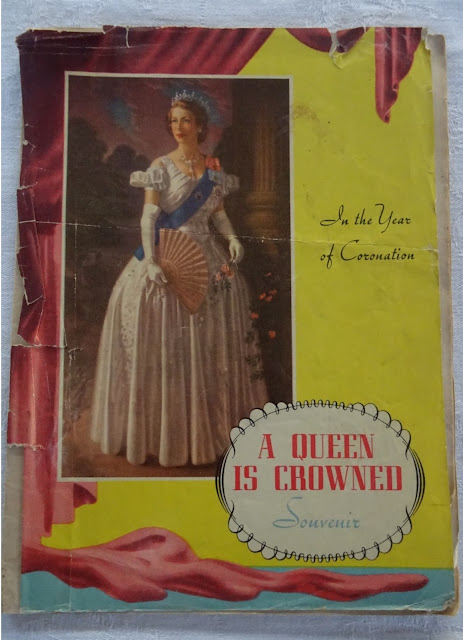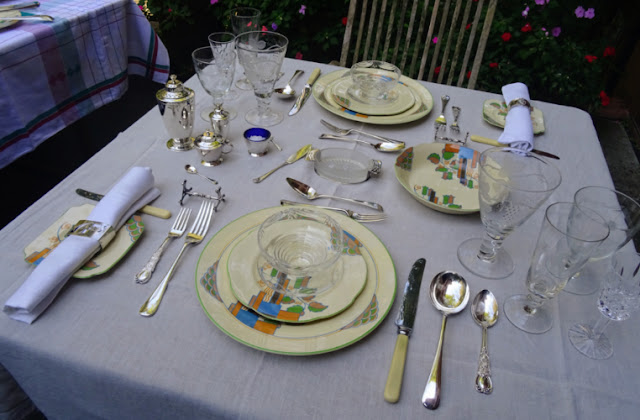1. How did you choose the menu and various elements you used in your setting, and why? Please explain each of the utensils at your setting… For which of the foods on your menu (or course) was each different item intended?


Luncheon Commemorating the Coronation
of
Her Majesty Queen Elizabeth II
on 2 June 1953
Prawn cocktail
Cream of celery soup
Duck confit, served with roast potatoes, cress salad, asparagus with mayonnaise
Selection of cheeses (Stilton, aged Cheddar)
Trifle
Tea & coffee
Cocktail:
Gin & tonic
(Gordon’s London Dry Gin)
Wines:
Champagne Moët & Chandon Impérial Brut
González Byass Tío Pepe Fino Sherry
Château Beauregard Pomerol 1999
Taylor’s 20-year-old Tawny Port
The above menu, I hope, reflects dishes and wines that were available and popular in Britain and elsewhere across the then Empire and Commonwealth in the 1953. One also has to bear in mind that wartime rationing had only ended recently. And not every household had electrical refrigeration, hence the duck confit. Trifle was and remains a popular dessert. Asparagus would have still been in season somewhere in the northern hemisphere in early June.
Being early summer, this meal has been set out on the terrace amid the flowers. (It rained in London, though, on the day of the Coronation.) The champagne is for a toast to the monarch. The Imperial label is appropriate to our late sovereign, who was queen of much of the world when she ascended the throne.Sherry and an aged claret (or burgundy) were regarded as the proper wines to serve with any fine meal. Port was and is de rigueur for cheeses and after a meal.
One hardly needs to explain the role that gin and tonic played in the Empire.

The crockery is prewar. The plates are the Royal Doulton Marina pattern, which came out in 1934. It was created, I believe, to commemorate the marriage of the glamorous Princess Marina of Greece to Prince George, Duke of Kent, who was an uncle of our late Queen.
The cut-glass champagne flutes and wine glasses date from the 1950s. The water goblets, I believe, are Victorian, while the sherry glasses are the Waterford Crystal Lismore pattern, which came out in 1957. The Stuart crystal bowls for the prawn (shrimp) cocktail bear a number indicating the design was registered in 1926.
The cutlery is mostly sterling silver in the Old English pattern. The Art Deco cruet set and the matching sugar caster are hallmarked for Sheffield 1932 and 1933. The butter dish has an additional hallmark for the 1935 Silver Jubilee of King George V and Queen Mary, the grandparents of our late Queen.
The menu card is on the dining wagon, which is serving as the sideboard. Experience has taught me that someone invariably knocks over the flowers or a wine glass trying to peruse a menu card set on the table. The silver biscuit box (for the cheese course) is hallmarked for Glasgow 1930. The black and white photo of our Queen was taken in 1952 at the start of her reign by Dorothy Wilding.2. Why did you choose this particular period in time to set your table? Please go into as much detail as you can.
I am a great fan of Art Deco, which lingered into the late 1940s and early 1950s. The Art Deco era brought together craftsmanship and mass production. Mass production won out from the 1950s.

Note my attire. No self-respecting gent in the early 1950s would have received visitors or ventured outside the house without a jacket and tie (or a hat for that matter). I was also wearing Coronation cufflinks, which I acquired over thirty years ago at a Salvation Army charity bazaar in Tokyo.
3. Have you always enjoyed a properly set table? Or, if not, was the table setting something you learned to enjoy through your social life and/or business later on in life? Proper food deserves a properly set table, beautiful surroundings, and good company. This is something I. have cherished from a young age.
4. Did you do any research on table setting etiquette before setting your elements at the table?
Not really. This is something that grew organically from my upbringing, love of antiques, and reading of history.5. Do you plan on entering again next year?
Yes.
6. Do you have any special memory they had of watching the Coronation or the Queen’s funeral (if any)?
The funeral of our late Queen was very moving. It’s hard to believe that Queen Elizabeth II is no longer with us. I greatly respected and admired the Queen for her selfless devotion to duty, her deep religious faith, her stoicism, humour, and impeccable style, and her ability to preserve her privacy and dignity in this goldfish bowl age.
 |
| Here is a coronation souvenir that belonged to my paternal grandmother. Again, Stephen, Elizabeth Soos and I say, “Bravo! And congratulations!” 👑 – Maura Graber |
🍽Etiquette Enthusiast, Maura J. Graber, is the Site Editor for the Etiquipedia© Etiquette Encyclopedia



No comments:
Post a Comment
Note: Only a member of this blog may post a comment.